Interview with Rit Mathis, Mathis Home and Alex Hase, Mirakl
Mathis Home’s entry into the marketplace arena shows how furniture retailers can simultaneously maintain their brand
identity, encourage in-store sales and defend against retail behemoths like Amazon.
Like many third-generation furniture store leaders, Rit Mathis followed in his father’s and grandfather’s footsteps. He
worked his way up from his first job at Mathis Brothers Furniture unboxing lamps to his current position as CEO.
“Don and Bud Mathis founded Mathis Brothers Furniture in 1960,” said Mathis. “They drove door to door buying furniture
to sell in their used furniture shop. It is one of those American dream stories about a couple of dirt-broke guys who
managed to build a successful business. They also became locally known for their 30-minute primetime segment on NBC here
in Oklahoma, a live television variety show featuring guests, songs and information about furniture."
Brick & Mortar
“In 2023, Mathis Brothers Furniture changed its name to Mathis Home while simultaneously launching its Marketplace
initiative.”
Today, Mathis Home operates large-footprint stores in Oklahoma and California. Their brick-and-mortar campuses include
Sleep Studios, Design Studios, cafes and Ashley Home stores. Furniture World asked Mathis to connect the dots between
Don and Bud’s variety show and selling nationally via the Mathis Home Marketplace.
Marketplace Strategy
“If you ask our customers what’s different about shopping at Mathis Home,” he replied, ”they will probably say that we
have the biggest and widest selection, offering many options and the best brands.
“There are plenty of other core strengths, such as our focus on continuous improvement and creating fun and friendly
work environments. But since you asked for the one that best connects Mathis Brothers to Mathis Home’s Marketplace
strategy, it’s the breadth and depth of our product offerings. We are a one-stop shop featuring price points from the
least expensive promotional items to heirloom-quality furniture.”
500,000 SKUs
With the help of Mirakl, a marketplace management company, Mathis Home has set a goal to expand its Marketplace product
selection beyond 500,000 SKUs by 2026. Mathis recalled, “The first step we took to kick off our e-commerce evolution was
to put our first party (1P) inventory online to give customers a more complete view of what we had to offer. The next
logical step was to add vendors that could quick-ship items delivered along with our first-party goods. That led us to
consider expanding our website, www.mathishome.com, to include thousands of additional SKUs from direct ship third-party
(3P) vendors."

Marketplace Defined
“First-party vendors provide inventory that sits on a rack in our DC. Second-party inventory is supplied by first-party
vendors as well. It’s made up of items we don’t keep in inventory. Third-party vendor products never touch our DC. They
are shipped directly from vendors who provide direct service and support to Mathis Home customers.
“The difference between a typical retailer’s e-commerce furniture website and a marketplace like Mathis Home’s or
Amazon’s is the ability to include third-party sellers,” added Alex Hase, Mirakl’s GM of the Americas. Mirakl
(http://mirakl.com), supplies online marketplace solutions and support to Mathis Home.
“It’s not two separate experiences. Mathis Home retains control over the products sold and is responsible for creating a
cohesive e-commerce experience.”
What About Amazon?
Some furniture retailers see large marketplaces like Amazon as existential threats to independent furniture retailers.
It’s been estimated that between 50% and 66% of US consumers start their web search for products on Amazon. And,
although the percentage of searches for furniture and bedding is probably much lower, it’s growing.
“Mathis Home’s entry into the marketplace arena,” Hase continued, “is a perfect example of how retailers can maintain
the integrity of their historical business while simultaneously defending against large marketplaces. Mathis Home’s
initiative brings together a high-quality brand with an expanded assortment. The objective is not to try to sell
everything to everybody.”
Mathis added, “Amazon and other online marketplaces have slowly carved out a good chunk of the home furnishings
business. I’ve seen statistics estimating Amazon’s current percentage at about eight percent. Plenty of furniture
retailers can’t afford to see an eight percent erosion in market share and survive.”
Onboarding 3P Vendors
“Onboarding third-party vendors is very different from the typical retail experience of meeting a first-party vendor at
a furniture market and connecting their e-commerce staff to ours. Getting all the image links and product details in
place for our 1P vendors can take six months.
Mathis continued, “We discovered early on that it would be a massive lift for our current staff to onboard a large
number of 3P marketplace vendors. Mirakl helps us skip 90% of the mundane and labor-intensive steps because the vendors
they work with have already completed the setup process. That makes it plug-and-play for new categories and products to
go live on mathishome.com in just a few weeks.” He further explained that this speed of onboarding allows Mathis Home to
shorten the time it takes to test inventory, categories and vendors.
“It’s important to quickly discover whether or not meaningful business can be done with new 3P vendors. Mirakl’s ability
to facilitate this has transformed our business.”
“Mirakl helps us skip 90% of the mundane and labor-intensive steps because the vendors they work with have
already gone
through the setup process.” Rit Mathis
e-Commerce Strategy
“Our e-commerce marketplace strategy,” he continued, “currently centers around supporting our brick-and-mortar business.
It’s an alternative for those consumers who, for whatever reason, don’t want to spend a Saturday afternoon shopping at a
Mathis Home location.
“When a furniture retailer adds a couple hundred thousand 3P items to its website, it opens up an equal number of side
doors for online shoppers to land keyword searches for specific products. Now that these products are available on
mathishome.com, we get the traffic and sales opportunities.
"Becoming a national e-commerce player will require additional investment to acquire users unfamiliar with our brand.
We’ve always received out-of-state traffic to our website. Now that drop-ship fulfillment has become a snap, it seems
realistic that we will be able to do a lot more business with customers outside our core trading areas.”
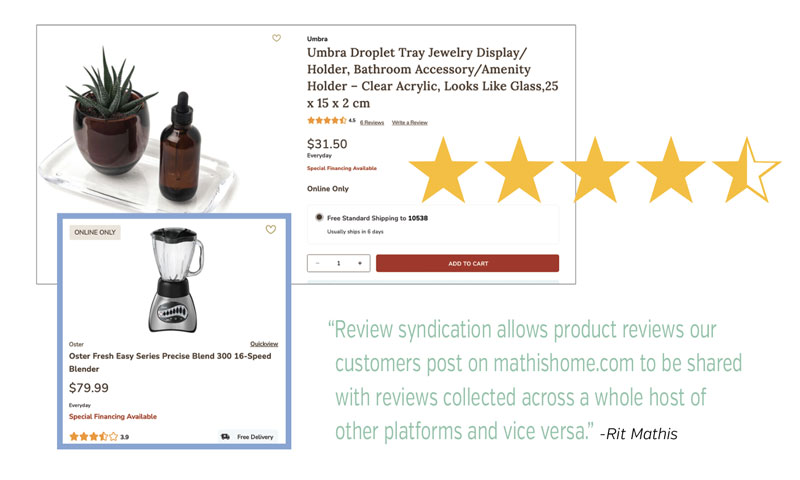
Adjacent Categories
“Recently, we’ve added installations within our stores to let customers know that Mathis Home now sells merchandise
categories beyond the core selections we are known for. These include small kitchen appliances, seasonal decor, baby
furnishings, bathroom sinks and vanities, kitchen utensils, organization tools for closets and garages and even pet
strollers. These are, generally speaking, items we don’t have space to add to our showroom displays.”
Synergies
“Interesting synergies between our in-store and Marketplace experiences have come to light," Mathis observed. “Earlier
this year, for example, when Pantone’s color of the year, Mocha Mousse, was introduced, it was under-represented on our
sales floors. However, the dozens of our Marketplace items that already fit this color profile suggested an opportunity.
We quickly presented a hot new color story, bringing Mocha Mousse to life in our marketing and on sales floors via our
3P vendors. We added a QR code to these items, encouraging shoppers to use their phones to transact on mathishome.com.
Salespeople get commission on Marketplace orders completed in-store or made once customers return to their homes as part
of mixed baskets of first- and third-party purchases.
“Typically, Marketplace purchases are not purely transactional. They are associated with the purchase of
first-party
products that are tied to Mathis Home’s historical value proposition. Alex Hase
“Most furniture retail salespeople have had the experience of getting a ‘stiff arm’ from shoppers they greet near the
front entrance. We want to make it easy for these shoppers to buy, whether it’s in-store or on our website. And,
although we’re at our best when we provide a personalized in-store experience, Mathis Home wants to make it comfortable
for shoppers looking for a fast, convenient and less personal purchase that ships right to their door.”
“Either way,” Hase added, “including salesperson compensation for Marketplace transactions is a best practice that helps
Mathis Home unlock its potential. It encourages higher average sales and reduces friction between in-store and online
sales experiences.”

Information Flows
“The attachment rate of third-party or Marketplace products to 1P Mathis Home items is north of 90%,” Hase explained.
“Typically, Marketplace purchases are not purely transactional. They are associated with the purchase of first-party
products tied to Mathis Home’s historical value proposition.”
All customer information from in-store and online purchases flows directly into Mathis Home’s Consumer Data Platform
(CDP). “If customers give us consent to market to them via SMS and emails,” noted Mathis, “our sales associates can
follow up in various ways. We sort customers into buckets by price point and category based on what they shopped for to
provide more personalized marketing and follow-up. For example, should someone purchase a stroller from the Mathis Home
Marketplace, an RSA may follow up with child-adjacent products and services to continue to build on the relationship.
And if they’ve previously purchased in-store, we can often connect them to an RSA they’ve previously worked with.
“We want our salespeople to see our e-commerce Marketplace as an opportunity. Every sales associate has worked with
customers who can’t find the items they are shopping for. It’s discouraging to send them back into the world to look
elsewhere. Our expanding Marketplace selection gives our RSAs more opportunities to continue to add to the sale.”
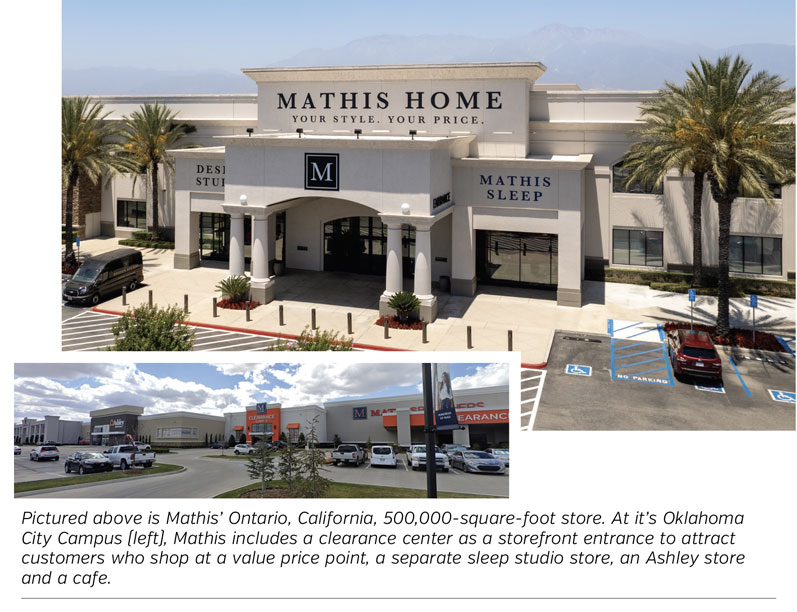
Finding the Right Partner
Furniture retailers considering a Marketplace solution should engage with an experienced technology provider. Finding a
company that knows what situations to avoid and how to deal with legacy systems is essential.
Mirakl advised Mathis Home on best practices to help get things off the ground. “We drove discussions about adding
adjacent categories and helped them understand factors that drive performance,” Hase said. "In most cases, retailers,
especially those the size of Mathis Home, continue to use their existing e-commerce providers. We extended Mathis Home’s
platforms to allow them to add third-party sellers, manage data flowing from the Marketplace ecosystem and ensure that
third-party vendors meet their service-level agreements (SLAs).”
“I recently pulled an e-commerce report,” Mathis recalled, “listing the 233 companies represented on our Marketplace.
Some third-party vendors we added were large companies already part of Mirakl’s Connect Ecosystem. Others were small and
were referred to Mirakl. Our in-house team can add new 3P vendors the old-fashioned way, but it’s much slower and
costlier.”
“Onboarding third-party vendors is very different from the typical retail experience of meeting a
first-party vendor at
a
furniture market and connecting their e-commerce staff to ours.” Rit Mathis
Retail Media Power
Another advantage of the Marketplace is that Mathis Home can now sell online advertising.
“Retail media,” Hase explained, “has been around for a long time in the form of in-store displays supplied by vendors.
Now, Marketplaces provide digital retail media opportunities, such as display ads and sponsored product listings, which
present new profit opportunities for retailers. Mirakl developed the retail media solution Mathis Home uses to sell
advertising inventory. The exposure benefits vendors that gain more access to consumers’ eyeballs on their path to
purchase.
"Mathis Home’s Marketplace platform can prioritize and serve sponsored advertising content from vendors to boost sales
of their products. It’s similar to the sponsored advertising we’ve all seen on Amazon.”
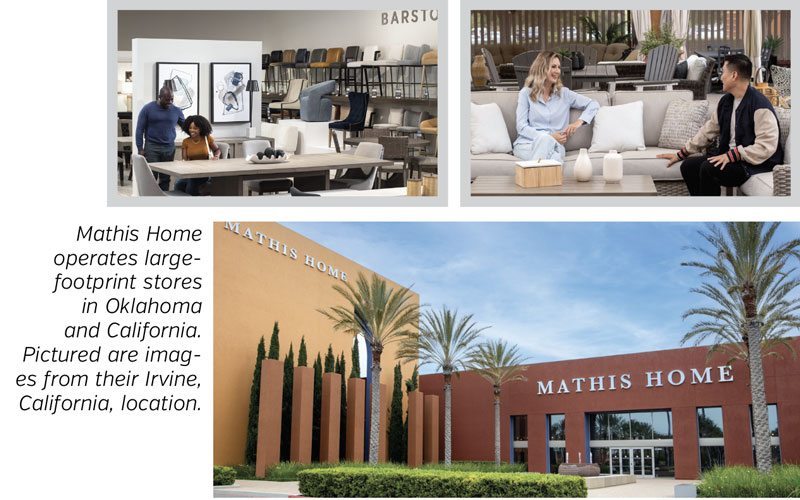
Surprising Statistics
Mathis told Furniture World, “Customers who purchase from mathishome.com may not notice a difference in the experience
of purchasing first-party and third-party products. In some cases, that’s true even after a product is delivered from
our distribution center or the DC of one of our 3P partners.
“Should there be a customer service issue, our third-party vendors are the first point of contact for customers. It
rarely becomes necessary for Mathis Home’s internal customer service department to get involved.”
-
Mathis shared the following performance stats for Mathis Home’s third-party vendors.
-
The average time from placing an online order on the Marketplace to shipping it is 27 hours.
-
The number of Marketplace refund requests is 4.09%. That number is much lower than Rit Mathis expected. Likewise, damage
incidents and late shipments haven’t been a problem, which has been a happy surprise.
“Our expanding Marketplace selection gives our RSAs more
opportunities to continue to add to the sale.” -Rit Mathis
Merchandising Control
Mathis Home has complete control over the products third-party vendors upload to mathishome.com. “Selections are vetted,” Mathis said, “to determine if items remain a significant value compared to pricing on other websites. Our staff also checks to ensure products are a good fit for the Marketplace and are supported by accurate product descriptions and rich media content.
“SKUs go live only after these factors pass our sniff check. As of today, we have 65,000 SKUs uploaded by our 3P vendors
that have not been approved, mostly for curation reasons. That’s more items than the total number most retailers display
on their websites.
“Mathis Home has set a goal to expand its Marketplace product selection beyond
500,000 SKUs by 2026.”
“We employ a small in-house team that reviews product uploads, but their main focus is to make contact with new vendors,
vet them, negotiate and finalize agreements, and follow up with vendors after agreements are signed to make sure
products continue to generate volume that’s meaningful for Mathis Home and our vendors.”
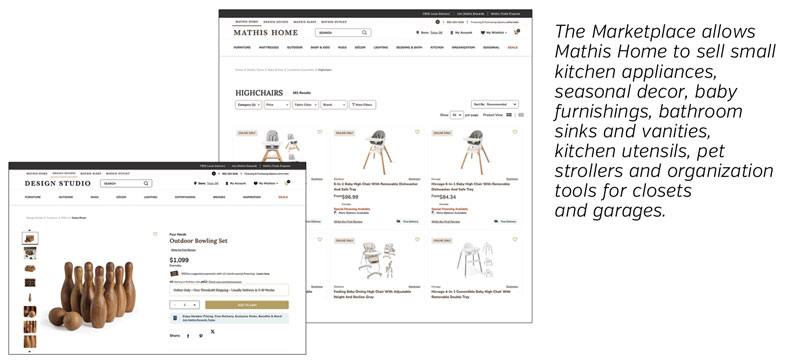
Product Review Syndication
Since shoppers rely heavily on online product reviews and ratings to guide decision-making on marketplace platforms, reviews are being added to mathishome.com with the assistance of Bazaarvoice (bazaarvoice.com) and PowerReviews (powerreviews.com). “Review syndication,” said Mathis, "allows product reviews our customers post on mathishome.com to be shared with those collected across a whole host of other platforms and vice versa. That way, we can immediately share, for example, many hundreds of user experiences with shoppers, even if it’s a newly added Mathis Home Marketplace item. It’s a confidence builder.”
“The difference between a typical retailer’s e-commerce furniture website and a marketplace like
Mathis Home’s or Amazon’s is the ability to include third-party sellers.” Alex Hase
Final Comments
“I believe we will see more retail consolidation in the furniture business over the next five to ten years,” Mathis
predicted. “Many formerly strong retailers will disappear as consumer buying patterns evolve toward convenience, speed,
selection and value. To prepare for this, traditional brick-and-mortar retailers like Mathis Home need to consider
blended approaches that include e-commerce-heavy strategies. We are still in the early days of our Marketplace
initiative and are optimistic about its chances for success."
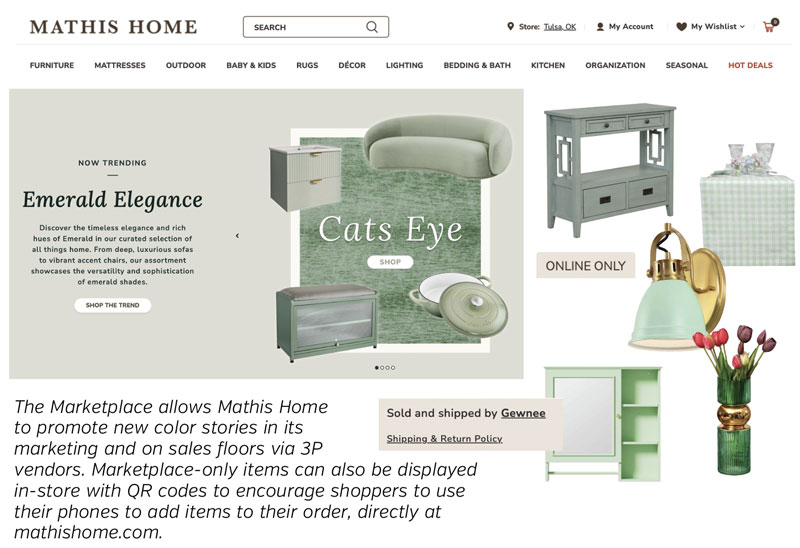
"I would add to Rit’s observation," said Hase, “the importance of crafting the right approach and attaining
near-flawless execution in any marketplace initiative. That’s what separates winners from the losers."